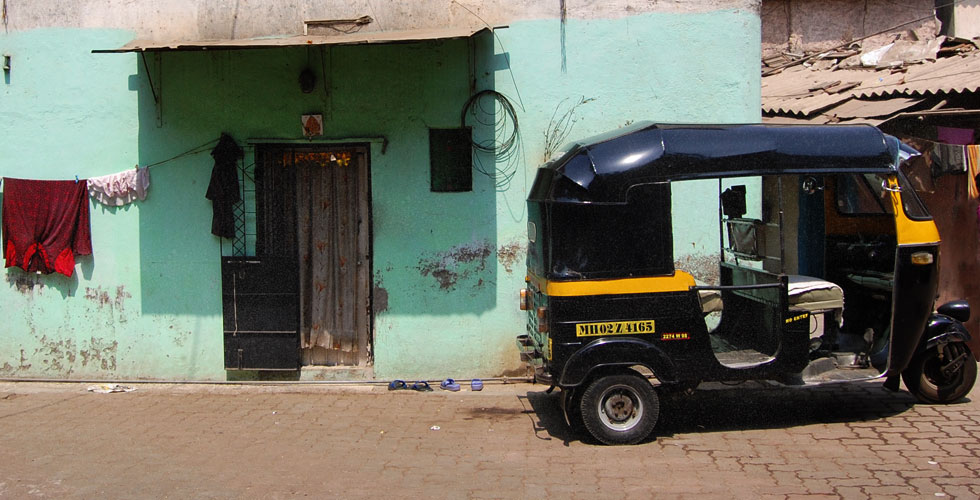
This little collection of buildings also claimed a rusting vending machine, an ancient petrol pump and a pack of half starved dogs who chased us along the track before giving up, exhausted by the heat and humidity



Ian Reynolds experienced India for the first time in 2010. He is an illustrator and graphic designer by trade and lives in the middle of the English countryside.
For more information on Ian visit his illustration website www.dreambird.co.uk or email him at [email protected]
The sun was a glow on the horizon, filtering through the red dust haze and touching everything with the most remarkable baked tones. The overgrown, patched and tumble down colonial style houses, painted in faded golds and lush dark greens had a grandeur and beauty that was stunning. There was a tidemark of rubbish and orange/red dust piled against every curb and walled garden. The worn, faded patterns of the ditch workers’ sarongs, their polished copper water pots and the blue plastic bags that made their shelters. The litter that swirled in dusty eddies around their feet. I took it all in in that moment. It might have been the 24 hours of travel it took to get there, or the lack of sleep, the high humidity even at dawn, but I found my wonderful revelation completely exhausting. It was a good job Sebby, our driver was on hand with his trusty converted van to give us our first taste of Goan driving.
We sat on an old sofa that had been shoehorned into the back of Seby’s ancient Bedford Rascal. The deafening din from the overworked engine made talking all but impossible but the air conditioning, courtesy of the glassless windows was very welcome. We wound our way along the main road south, which would be no more than a B-road in the UK. Every now and again the lush jungle with its vivid hues, Bougainvillea flowers, Mango and Cashew trees would open up to give glimpses of the Indian Ocean and tiny fishing villages. These villages comprised of no more than wood and corrugated shacks all brightly painted, many bearing beautifully hand-rendered signs advertising various local products (beer usually).
Occasionally, quite incongruously, we passed large boat hulks pulled up amongst the palm trees and vegetation. All the time Seby was weaving in and out of the growing number of tuc-tucs, bicycles and pedestrians that were emerging even at such an early hour. Despite the almost constant tooting of his horn, nobody seemed to take any notice as he belted past them with literally inches to spare. How he didn’t hit anyone, I’ll never know, but everyone seemed to drive with the same complete disregard for safety. It was both terrifying and exhilarating and the quite mind-blowing sights that we passed will remain with me always.
We turned off the noisy, congested road and we followed a dusty, winding track though the hills. At times some of the steeper gradients, deeply rutted tracks, eroded by landslides seemed extreme enough to challenge even a Land Rover, but somehow Seby managed to keep us from rolling off as we plummeted and bounced along the path hacked out of the jungle hillside. We drove for quite some time, only once driving past the only sign of civilization - a small collection of woven palm leaf and shacks, burnt to silver under the suns’ fierce heat. This little collection of buildings also claimed a rusting vending machine, an ancient petrol pump and a pack of half starved dogs who chased us along the track before giving up, exhausted by the heat and humidity. Soon after, to our immense relief, the track simply vanished in front of us. We had arrived!
Our relief at getting out of Seby’s sweat box, was marred by the overwhelming sense that we had made a grave mistake. There was nothing here except a turning space in the jungle and a wooden railing made from rough-cut palm wood. Seby unloaded our packs and smiled cheerfully at us as we considered heading back to the rabid dogs in the village. He pointed at the railing and explained that it was the start of the climb down to the beach. Sure enough, rough and uneven steps had been dug out of the incline. Every so often there was a set of railings to help us keep our balance until quite suddenly the jungle gave way to white sandy floor dotted with coconut palms. We had arrived at Cola Beach, the most wonderful cove I have ever stayed at.
There was a curving strip of white sand, about a mile long. Coconut palms lined the shore and dugout canoes were pulled up at one end in front of a tiny fishing village. It was idyllic. It was like one of those Bounty adverts from the 70’s. Truly a taste of paradise. As we sat alone at the waters edge, watching the sun set over the headland and listening to the cook prepare our evening meal, a dolphin leapt high out of the sea before us. It was yet another perfect moment. But like everything about India, wherever you turn, an equal balance of
immense beauty and ugliness greets you. This moment was no exception as we realised that the tide had also washed up a colourful assortment of plastic bottles and other detritus around our feet. India: I couldn’t help but fall in love.


















